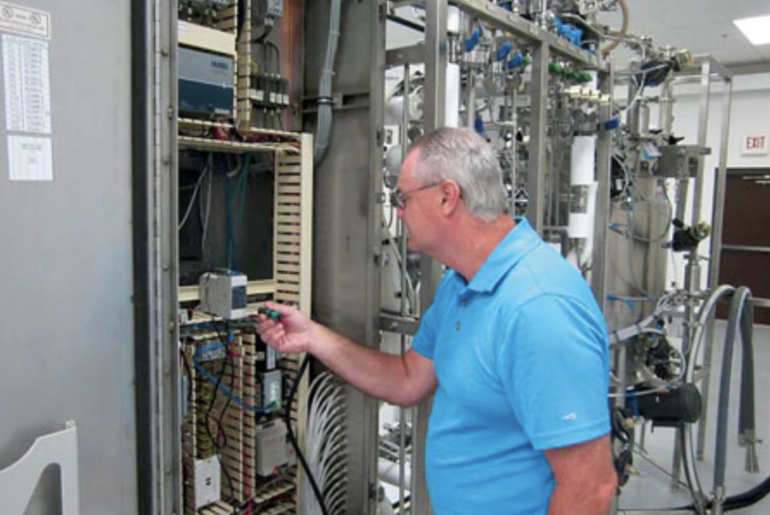Introduction
Whenever there is a case for overflow or to detect the rise of liquid beyond a certain point, sensors, mainly a vibrating fork level switch, are used to indicate such a condition or set off an alarm whenever the liquid is about to go over a certain level.
These are point measurement devices with a preset level condition and are usually used to indicate an overfill, and set off an alarm for a high level of fluid or low level.
Construction
A tuning fork-shaped element for sensing has two prongs inserted into a container, closed vessel, or tank to measure the liquid present inside.
Typically there is a piezoelectric assembly consisting of two piezoelectric elements or crystals, usually made of quartz present in or connected to the two mechanical forks. It drives the mechanical forks to oscillate at a natural frequency. The rest of the circuit connects to a sensor or an alarm.
Manufacturers usually prefer stainless steel, along with alloys, coatings, or other materials used for protection against corrosive or toxic substances, for manufacturing the device as it is apt for the high pressure and temperature conditions.
The construction of the device should be in such a way that the fork sensing element can vibrate freely in the absence of any liquid or material inside the container.
Principle
A vibrating fork level switch functions on the principle of resonance or natural frequency through a harmonic motion established using piezoelectricity. The frequency vibrates with the natural frequency of the piezoelectric crystals present inside to generate an electric current that flows through the circuit to set off a signal or an alarm.
Working
The sensing element will be set into vibration at a frequency equal to its resonant frequency by vibrating the sensing element in the fork. When the piezoelectric crystals are under forces of compression or tension, they generate an electric signal.
On the other hand, when electricity works on these crystals, they produce a vibrating motion.
This motion gets transferred to the fork or the sensing element, and vibration occurs at the resonant frequency of the mechanical fork.
A second piezoelectric crystal transforms the vibration motion from the first piezoelectric crystal back to an electric signal. The electric circuit in a measuring system sees this as a state where a material or medium is not present.
However, when the medium or fluid in consideration becomes present, the vibration frequency changes, and the electric signal from the second piezoelectric crystal gets changed.
It is through this method that a vibrating fork level switch detects the presence of a fluid or medium.
When in air, the forks vibrate at a natural frequency whereas in a medium, when liquid hinders the vibration motion of the two forks, the oscillation frequency drops which in turn is picked up by a sensor or a circuit that changes the output state to trigger an alarm or valve.
Characteristics
- Can work in temperature ranges of up to 200° C
- Fast switching by less than a second to ensure a quick response to change in medium.
- No moving parts
- Can withstand pressures of up to 40 bar.
- Selectable high-level or low-level alarm options with adjustment option for sensitivity.
- Can handle a wide range of power supplies.
Advantages
- Calibration is independent of material or medium properties, so no calibration required.
- No wear and tear since no moving mechanical parts are available.
- Lasts longer without repair or maintenance
- Accurate monitoring of high-level or low-level conditions of liquids, fluids, fine-grained solids, granules, and powdered solids.
- Not affected by physical properties such as turbulence, flow, presence of foam or bubbles, the vibration of the outside environment, liquid properties, variations in product, coating materials, and composition of solids.
- Easy to install various switches in the continuing vessel or chamber
- Setting up the circuit and commissioning is possible without the requirement of contact of the medium.
- Measurement is independent, to a high degree, of the position of installation, pressure, and temperature of the medium or the fluid and the environment.
Applications
- Mostly installed in areas that have the most demanding environments, especially dangerous or hazardous areas.
- Is perfect for places that require point level detection for alarms, monitoring, and control application.
- Overflow (high-level triggers) or dry run (low-level triggers) detection of liquids, namely oils, petroleum, corrosive liquids, and water.
- This switch is perfect for the detection of solids such as powder, granular plastics, and gravel.
Areas of Installation
- Storage Silos
- Containers
- Vessels
- Holding Ponds
- Natural Bodies of Water
With certain limitations such as not being suited to work under very viscous media and also chances of material build-up between forks that can hinder correct measurements, the benefits far outweigh the disadvantages for this particular device.
The vibrating fork level switch is indeed a reliable and cost-effective means to measure or detect liquids and bulk solids in the container or vessel.

